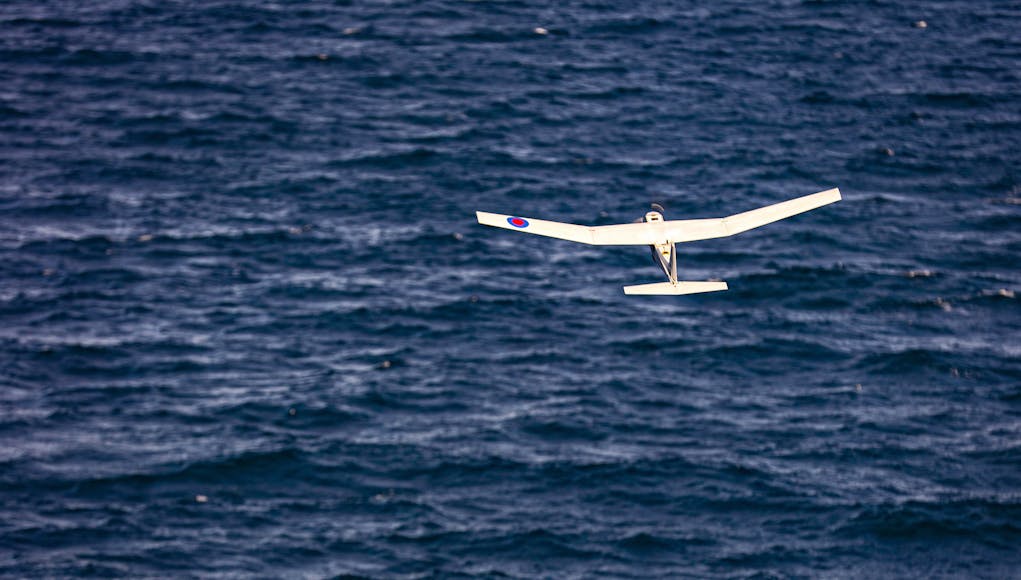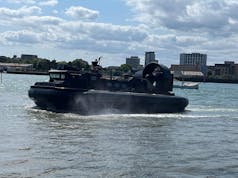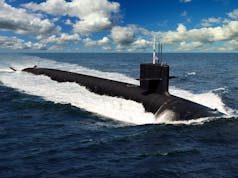HMS Tamar has made extensive use of a small Puma remotely piloted aircraft during trials as the ship practices for ‘constabulary duties’ when she deploys for the first time this summer.
The Royal Navy say that constabulary duties – counter piracy/terrorism/smuggling – are a key role of the new batch of River-class ships.

“Typically the vessels will work with Royal Marines boarding teams – a 50-man mess has been built into the ships to accommodate them. But there may be occasions when Tamar may be called on to work with local law enforcement agencies (such as her sister HMS Medway has been doing in the Caribbean, striking at drug-runners with the US Coast Guard).
The combined training with the Metropolitan Police in the Channel proved extremely useful for both the Navy and UK’s largest police force. The Met used Tamar as their ‘floating headquarters’, turning her into a command and control vessel to marshal their RIB speed boats. The latter are used to the sheltered waters of the Thames – their normal domain ends at Dartford Creek – and found operating in the choppy Channel rather difficult.”

Puma is relatively cheap – certainly much cheaper than sending a helicopter up – easy to launch and recover, is difficult for foes to spot and keeps the ship out of harm’s way. In short, Puma gave Tamar ‘eyes in the sky’.
According to a Royal Navy news release:
“The Puma could fulfil some of the helicopter’s intelligence-gathering role – with its 50-times zoom camera it feeds live footage back to a mother ship at ranges up to a dozen miles. Building on their experiences aboard HMS Albion in the Mediterranean last year, a team from 700X Naval Air Squadron – the Fleet Air Arm’s only pilotless squadron – brought their drone to Tamar.
Just over 4½ft long, with a wingspan of 9ft and weighing as much as six bags of sugar, Puma can survey an area of up to 270 square miles of ocean – that’s larger than Greater Manchester – looking for suspicious activity during sorties lasting up to 2½ hours.”














Is this just early days, as to me the Puma whilst an extra string on the bow, looks a little limited, wouldn’t the RN be better off using the Scan eagle (Of which it apparently already uses) personally I would like the Uk to have a butchers at Skeldar
https://umsskeldar.aero/our-products/rpas-systems/v-200-skeldar/
Scan Eagle has a very large footprint. Big boxes for wings and body. Big wheeled launcher. Catcher. Data link domes.
Puma is far smaller and hand launched. It probably uses Rover 4 type encrypted data links over a ruggedised laptop.
Simple and easy.
I couldn’t agree more. We need the V200. We need to put in an order large enough for economies of scale. These are needed for all Rivers, T23, then T26, T31, T32, T45 & T4X.
Without going into detail – you need to be careful when evaluating a drone from the companies own website. Manned aviation standards are not applied and have to be assessed carefully. Better to see what the German Navy trial effort finally produces: https://www.navalnews.com/naval-news/2020/08/german-navy-starts-at-sea-tests-of-skeldar-v-200-vtol-uav-aboard-k130-corvette/
V200 is as tall as a person 5m end to end and weighs a quarter of a tonne, its essentially a half size robotic helicopter. You have to consider deck space and storage requirements as well.
What is the cost differential to a s100? One of v200 or s100 for sure on all b2 rivers but really on all ship on for each 30 mm gun they Cary so up to 4 on qe2.https://schiebel.net/products/camcopter-s-100/
V200 costs $4m for 2 aircraft and one ground station. So Puma $250,000 is roughly a tenth the cost.
Kinda like a super-effective “crows nest” lookout.
I saw this on the RN News site. Was expecting to see a high tech nano drone. Turns out it is an Airfix with a camera. Oh well, I’m not having a go, if it works it works I guess.
It is a bit limited and no use for hot stuff.
But it is the correct level for constabulary duty and you won’t cry if you lose one in the drink. It is cheap enough to you can probably have an embarked spare.
With the advances in cheap low light cameras these things will be pretty useful combined with ships radar, ships elint and satellite data.
I’m not sure that adding fullradar to a constabulary drone would be all that useful: maybe passive receiver only radar might be the way to go if you had to.
Hi SB
This looks a bit delicate…. do you know if can fly in poor weather….. and what’s it’s endurance
Thanks Ian
Original version has a range of 15 Kms, max 2 hour endurance with top speed @ 50 mph and stall speed of 23 mph.
Doesn’t look much for >$250,000!
With such a modest range, how much more use is it than a good set of binoculars or telescope?
Thank you Peter S
we seem to be behind the curve with this…….
im honestly surpised this ability has taken so long….. ok so drones give it autonomy, but that particular drone is just a large rc plane with a camera…..take the autonomy away and thats been available for years to the hobby community…..
It adds a capability the vessel did not have, whatever the faults and shortcomings. I suppose a helicopter or a Harrier would have more capability, but…
i just mean im surprised ships havent been launching things like this for a lot longer….
So how many of these assets are the RN getting? Each RB2 should have them as standard.
Or is this another of the seemingly endless trials that never progress further than yet another trial years later!
I feel this is most likely Daniele Mandelli
Curious how would it be recovered at the end of the flight? Draw straws for who is going to catch it.
Could they in theory send up 2 or 3 and cover a much larger area at once?
With such a small size, I suspect the stall speed of the drone is equal to or just over the top speed of the ship, meaning it would be easy enough to land on the flight deck at speed.
I think they fly into a cargo net at low speed for recovery.
So the same price as a new Aston Martin Vantage. @$250K. ++
That rather puts it in perspective. I’m sure I built a similar thing as a kid…..Keilcraft or something like that. Balsa wood, tissue paper and dope….the elastic band drive was a bit of a let-down though. I built a Supermarine Swift once with a jet ex pack….bloody thing caught fire!
Sounds like the profit margins BAE run off!
LOoks really good, would be useful on river b1 and 2 then maybe firescout on bigger ships in shooting environment
Puma UAV is a very nice system, I think.
see https://www.avinc.com/tuas/puma-ae
It uses battery = no flammable needed. It can (almost) crash land on the deck or in salty water. Designed to withstand such shock/environment. (see movie in the web). Its endurance, image stability, toughness are far exceeding those of RC plane or simple drones in the store. And, it is battle proven.
Look very promising. Cheap and handy. Puma UAV is in different category to Camcopter (or alike), like a bike and a car. I think UK shall buy ~50 of Puma UAV and carry 2 to 3 each on all escorts, RFAs, OPVs and Survey ships when deployed. As buying a bike does not prohibit buying a car, buying Puma can go along with buying AW-Hero or Camcopter or ScanEagle for more high-level of tasks, as operating the latter assets will be very expensive (although still much cheaper than a Wildcat).